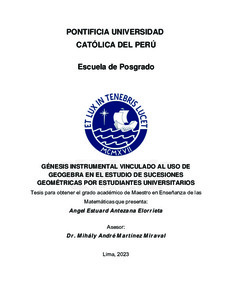| dc.contributor.advisor | Martínez Miraval, Mihály André | |
| dc.contributor.author | Antezana Elorrieta, Angel Estuard | |
| dc.date.accessioned | 2024-02-22T14:55:42Z | |
| dc.date.available | 2024-02-22T14:55:42Z | |
| dc.date.created | 2023 | |
| dc.date.issued | 2024-02-22 | |
| dc.identifier.uri | http://hdl.handle.net/20.500.12404/27159 | |
| dc.description.abstract | La revisión de la literatura centrada en la noción de sucesión geométrica permite
identificar el predominio del campo algebraico al abordar dicha noción, relegando con ello el uso
de tecnologías digitales en el proceso de enseñanza-aprendizaje de los estudiantes que
posiblemente podrían generar aprendizajes más completos. Es, en ese sentido, que se realiza
esta investigación, el cual tiene por objetivo analizar cómo se produce el proceso de génesis
instrumental vinculado al uso de GeoGebra al desarrollar una actividad sobre sucesiones
geométricas con estudiantes universitarios.
Para el análisis, se toma en cuenta aspectos del Enfoque instrumental como sustento
teórico y se emplea una metodología de carácter cualitativo, el cual permite analizar y describir
los conocimientos matemáticos que moviliza el estudiante cuando resuelve una tarea, mediado
por un ambiente de representación dinámica como GeoGebra, así como interpretar las acciones
que realiza el estudiante con dicho software. Como parte del proceso metodológico, se considera
un conjunto de fases que van desde el planteamiento del problema hasta las conclusiones del
estudio, además se brindan recomendaciones para futuras investigaciones.
Se puede afirmar, a partir de los resultados de la secuencia de la actividad, que el sujeto
de investigación utilizó un conjunto de herramientas de GeoGebra que le permitieron movilizar
diferentes nociones matemáticas, como polígonos, áreas, puntos medio, funciones, entre otros,
potenciando las propiedades del software y transformándolo en un instrumento para caracterizar
la noción de sucesión geométrica.
Se concluye del estudio la importancia del uso del ambiente de geometría dinámica como
GeoGebra, como complemento de los procesos algorítmicos y analíticos propios de la
Enseñanza de las Matemáticas, brindando un aprendizaje más completo al conectar las
diferentes representaciones del concepto estudiado de forma simultánea. | es_ES |
| dc.description.abstract | The review of the literature focused on the notion of geometric sequence allows us to
identify the predominance of the algebraic field when approaching this notion, thereby relegating
the use of digital technologies in the teaching-learning process of students that could possibly
generate more complete learning. It is, in this sense, that this research is carried out, which aims
to analyse how the process of instrumental genesis linked to the use of GeoGebra is produced
when developing an activity on geometric sequences with university students.
For the analysis, aspects of the Instrumental Approach are taken into account as
theoretical support and a qualitative methodology is used, which allows us to analyse and
describe the mathematical knowledge mobilised by the student when solving a task, mediated by
a dynamic representation environment such as GeoGebra, as well as to interpret the actions
performed by the student with this software. As part of the methodological process, a set of
phases is considered, ranging from the statement of the problem to the conclusions of the study,
and recommendations for future research are also provided.
It can be affirmed, from the results of the activity sequence, that the research subject used
a set of GeoGebra tools that allowed him to mobilise different mathematical notions, such as
polygons, areas, midpoints, functions, among others, enhancing the properties of the software
and transforming it into an instrument to characterise the notion of geometric succession.
The study concludes the importance of the use of the dynamic geometry environment
such as GeoGebra, as a complement to the algorithmic and analytical processes of Mathematics
Education, providing a more complete learning by connecting the different representations of the
concept studied simultaneously. | es_ES |
| dc.language.iso | spa | es_ES |
| dc.publisher | Pontificia Universidad Católica del Perú | es_ES |
| dc.rights | info:eu-repo/semantics/openAccess | es_ES |
| dc.rights.uri | http://creativecommons.org/licenses/by/2.5/pe/ | * |
| dc.subject | Matemáticas--Estudio y enseñanza (Superior) | es_ES |
| dc.subject | Geometría--Estudio y enseñanza (Superior) | es_ES |
| dc.subject | Geometría--Enseñanza con ayuda de computadoras | es_ES |
| dc.subject | Tecnología educativa | es_ES |
| dc.title | Génesis instrumental vinculado al uso de GeoGebra en el estudio de sucesiones geométricas por estudiantes universitarios | es_ES |
| dc.type | info:eu-repo/semantics/masterThesis | es_ES |
| thesis.degree.name | Maestro en Enseñanza de las Matemáticas | es_ES |
| thesis.degree.level | Maestría | es_ES |
| thesis.degree.grantor | Pontificia Universidad Católica del Perú. Escuela de Posgrado | es_ES |
| thesis.degree.discipline | Enseñanza de las Matemáticas | es_ES |
| renati.advisor.dni | 10287257 | |
| renati.advisor.orcid | https://orcid.org/0000-0001-7734-1223 | es_ES |
| renati.author.dni | 74311376 | |
| renati.discipline | 199117 | es_ES |
| renati.juror | García Cuéllar, Daysi Julissa | es_ES |
| renati.juror | Martínez Miraval, Mihály André | es_ES |
| renati.juror | Peñaloza Vara, Tito Nelson | es_ES |
| renati.level | https://purl.org/pe-repo/renati/level#maestro | es_ES |
| renati.type | https://purl.org/pe-repo/renati/type#tesis | es_ES |
| dc.publisher.country | PE | es_ES |
| dc.subject.ocde | https://purl.org/pe-repo/ocde/ford#5.03.01 | es_ES |







